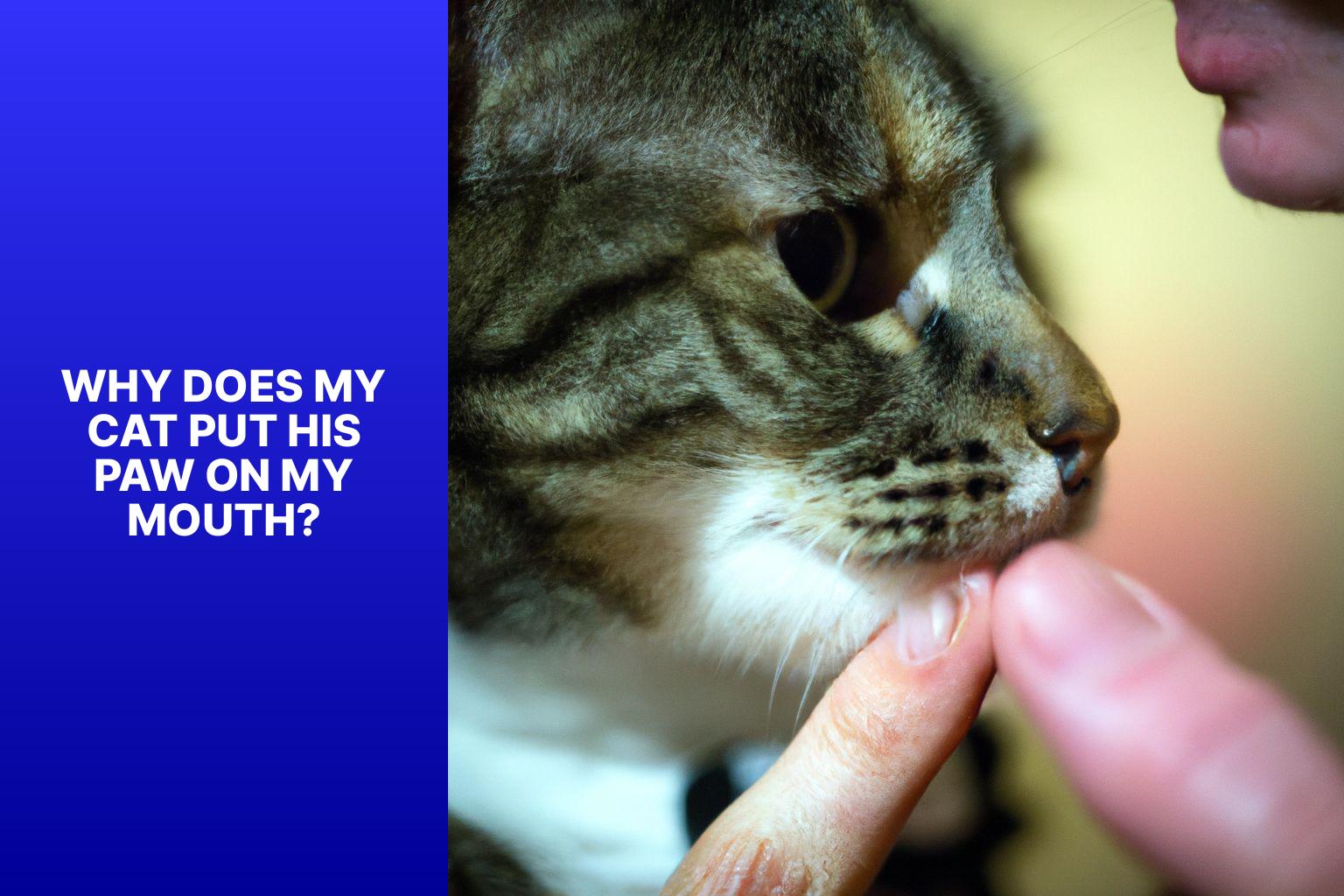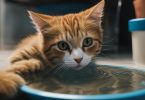Cats are known for their mysterious behaviors and quirky habits, and one such behavior that may leave you wondering is why your cat puts its paw on your mouth. While there can be various reasons behind this peculiar behavior, it is essential to understand that it is a natural part of feline communication. Here are some possible explanations as to why your cat engages in this behavior:
1. Instinctual Behavior: Cats have inherited certain instinctual behaviors from their wild ancestors. Placing their paw on your mouth can be a way for them to establish dominance or assert their presence.
2. Marking Territory: Cats have scent glands in their paws, and by placing their paw on your mouth, they may be marking you as part of their territory, similar to how they rub their scent on objects.
3. Seeking Attention: Cats love attention and may use their paws to get your attention. By pawing at your mouth, they may be trying to engage you or communicate their needs, such as wanting food, playtime, or affection.
4. Showing Affection: For some cats, placing their paw on your mouth can be a gesture of affection. It may be their way of showing that they feel comfortable and safe in your presence.
5. Mimicking Hunting Behavior: Cats are natural hunters, and pawing at objects, including your mouth, can be a way for them to simulate hunting behavior. It may indicate that your cat sees you as prey or simply wants to engage in playful behavior.
Understanding your cat’s body language and behavior cues can help you decipher the reasons behind their actions. Keep in mind that each cat is unique, and their motivations may vary. It is essential to observe your cat’s overall behavior and consider their individual personality when trying to comprehend why they put their paw on your mouth.
Key takeaway:
- Instinctual Behavior: Cats putting their paw on your mouth may be a result of instinctual behavior, such as marking territory or mimicking hunting behavior.
- Seeking Attention: Your cat may be pawing at your mouth to seek attention and interaction from you.
- Showing Affection: Putting their paw on your mouth can be a way for your cat to show affection towards you.
Why Does My Cat Put His Paw on My Mouth?
Photo Credits: Www.Catcornerblog.Com by Bradley Green
Curious about why your feline friend puts their paw on your mouth? Let’s dive into the intriguing behavior of cats and explore the reasons behind this gesture. From instinctual behavior and marking territory to seeking attention and showing affection, we’ll uncover the diverse motivations behind your cat’s paw placement. We’ll also touch upon mimicking hunting behavior and understanding the perspective of non-cat enthusiasts. We’ll address behavioral issues, personal space, and ensuring your cat’s comfort and safety. Stay tuned to discover effective ways to communicate with your cat and how to respond to their meow demands. Plus, we’ll discuss seeking veterinary advice and adjusting sleeping habits for optimal harmony. Are you ready to unravel the secrets behind your cat’s adorable yet puzzling behavior? Let’s jump right in!
Instinctual Behavior
Cats exhibit their instinctual behavior in various ways, one of which is by placing their paws on their owners’ mouths. This behavior is deeply rooted in their natural instincts and serves multiple purposes.
Cats use their paws as a means of communication. Placing a paw on the mouth may be their way of requesting attention or expressing affection towards their owners.
Cats have scent glands located in their paws. By touching their owners’ mouths, they might be marking their territory and asserting ownership.
Cats utilize their paws to catch and hold prey. Placing a paw on the mouth could be a way for them to practice their hunting skills or imitate this behavior.
Cats seek warmth and comfort in the presence of their owners. Hence, placing a paw on the mouth could be an attempt to seek warmth and security.
Understanding and respecting your cat’s instinctual behavior is vital. Excessive paw placement may indicate the presence of a behavioral issue that requires attention. It is important to create a comfortable and safe environment for your cat and provide suitable outlets for their instincts, such as toys or scratching posts.
Similarly, my cat Whiskers often places his paw on my mouth when he wants attention. This behavior began when he was a kitten and has now become his way of communicating his needs. I interpret this behavior as a gesture of affection and a desire for interaction. Understanding his instinctual behavior has strengthened our bond and improved our communication.
Marking Territory
Cats have a natural instinct to mark territory, and they do this by placing their paws on your mouth. This not only establishes their ownership and dominance but also leaves their scent on you.
Unneutered and unspayed cats tend to have a stronger desire to mark their territory.
To redirect this behavior, it is helpful to provide scratching posts, toys, and vertical spaces like cat trees.
If marking becomes excessive or problematic, it is advisable to consult a veterinarian or animal behaviorist for guidance.
Seeking Attention
Cats may seek attention by touching your face in order to engage with you and get your attention. They are essentially saying, “Hey, pay attention to me!“
Cats are social animals and have a strong need for attention to fulfill their social needs. It’s crucial to respond to your cat’s attention-seeking behavior and provide them with the interaction and affection they crave. This can involve petting them, playing with them, or simply acknowledging their presence.
Nevertheless, it’s important to also respect their personal space. If your cat excessively or aggressively places her paw on your mouth, it is advisable to consult a veterinarian to rule out any underlying issues.
Reacting positively to your cat’s attention-seeking behavior can help strengthen the bond between you and your feline friend while also improving their overall well-being.
Showing Affection
Showing affection is a common behavior demonstrated by cats towards their owners. Cats show affection as a way to express love and bond with their owners. Understanding the different ways that cats show affection can help strengthen the bond between you and your furry friend.
– Purring: Cats purr when they are happy and content, showing their affection and relaxation.
– Head nudges: When your cat gently bumps their head against you, it is a sign of trust and affection, marking you as part of their social group.
– Kneading: Cats knead with their paws, often on soft surfaces or on their owners, as a way of finding comfort, relaxation, and expressing affection.
– Gifts and play: Cats may bring you small gifts, such as toys or prey, to show their love. Engaging in playtime with your cat is another way they express affection.
– Slow blinking: When your cat slowly blinks at you, it is a sign of trust and affection. This is known as a “cat kiss” and can strengthen your bond if you reciprocate.
To strengthen your bond with your cat and show affection in return, respond positively to their gestures, offer gentle strokes, and spend quality time playing and cuddling together. Remember to understand and respect their boundaries, as each cat may have different preferences for affection.
Mimicking Hunting Behavior
Edited
Mimicking Hunting Behavior is a natural instinct for cats. Cats imitate hunting behavior by following these steps:
- Cats stalk by crouching low and moving silently towards their target, similar to hunting prey in the wild.
- Cats pounce by leaping forward with their paws outstretched, imitating the motion of catching prey.
- After pouncing, cats use their front paws to grab and hold onto their “prey,” as they would when catching a small animal.
- Cats may gently or playfully bite their “prey” to simulate the final step of hunting, delivering a killing bite.
- Cats may repeat these steps multiple times, enjoying the playfulness and mimicking the rhythm of a real hunting sequence.
By mimicking hunting behavior, cats satisfy their natural instincts for physical activity, mental stimulation, and hunting. It can also serve as a way for them to release energy and bond with their owners. Providing appropriate toys and playtime is important to ensure cats engage in this instinctual behavior safely and without causing harm. Understanding and encouraging this behavior can lead to a happy and fulfilled feline companion.
Understanding Non-Cat Enthusiasts’ Perspective
Non-cat enthusiasts may struggle to understand why a cat puts its paw on their mouth. Cats have their own behaviors and ways of interacting with humans.
1. Misinterpretation: Non-cat enthusiasts might see this behavior as invasive or aggressive. They may not realize that a cat’s paw on the mouth is often a sign of affection or a way to seek attention.
2. Fear of Scratching: Some non-cat enthusiasts may worry about being scratched by a cat’s paws. It is important to teach them proper cat handling techniques and explain that a cat’s paw on the mouth is usually harmless and not intended to cause harm.
3. Lack of Understanding of Cat Behavior: Non-cat enthusiasts may not be familiar with cat behaviors and body language. They may not realize that a paw on the mouth is just one way cats communicate and show affection.
4. Personal Space Invasion: Non-cat enthusiasts may have a strong need for personal space and feel uncomfortable when a cat invades that space. It is important to respect their boundaries while helping them understand the cat’s behavior.
5. Allergies or Fear: Non-cat enthusiasts may have allergies or a fear of cats, making any physical contact unwelcome, including a paw on the mouth. It is important to be considerate of their discomfort and find alternative ways to interact with the cat.
Understanding Non-Cat Enthusiasts’ Perspective can foster understanding between cat lovers and those less comfortable around cats. By educating, reassuring, and empathizing, we can create a harmonious environment for both cats and non-cat enthusiasts.
In a true story, Jessica, a non-cat enthusiast, was initially confused when her friend’s cat repeatedly placed its paw on her mouth. She felt uneasy and unsure how to react. After learning about cat behavior and understanding that the gesture was a sign of affection, her perspective changed. Jessica realized that the cat was trying to connect with her in its own way. With this new understanding, she was able to enjoy her interactions with the cat, feeling more comfortable and appreciating the unique bond they formed.
Addressing Behavioral Issues
- Use positive reinforcement: Reward your cat with treats and praise when they exhibit desired behavior, such as not putting their paw on your mouth.
- Redirect their behavior: If your cat consistently puts their paw on your mouth, redirect their attention to a more appropriate behavior like playing with a toy or grooming themselves.
- Provide appropriate outlets: Ensure your cat has plenty of toys, scratching posts, and interactive playtime to keep them mentally and physically stimulated, preventing unwanted behaviors.
- Establish boundaries: Set clear boundaries with your cat and consistently reinforce them. For example, if you don’t want your cat on the kitchen counters, use deterrents like sticky tape or aluminum foil.
- Consult a professional: If you can’t address your cat’s behavioral issues on your own, consider seeking help from a professional animal behaviorist or veterinarian.
A true history: One cat owner had a persistent issue with their cat putting its paw on their mouth. They tried redirecting behavior and setting boundaries but sought professional help. The behaviorist observed their interactions and found that the cat wanted attention and affection. By implementing structured playtime and increasing interaction, the owner successfully addressed the issue. The cat no longer felt the need to put its paw on the owner’s mouth as it received the desired attention.
Respecting Personal Space
When it comes to cats, respect their personal space. Cats are independent creatures and value their personal boundaries. By respecting their personal space, you can create a trusting and comfortable environment for your feline friend.
1. Avoid forcing physical contact: Cats have different comfort levels with physical touch. Some cats enjoy being cuddled and petted, while others prefer their own space. Pay attention to your cat’s body language and cues to understand their comfort level.
2. Give them their own space: Cats need a designated area where they can retreat for alone time. Provide a cozy cat bed or a quiet corner where they can relax undisturbed. This will help them feel safe and secure.
3. Avoid sudden movements: Cats are sensitive to sudden movements and loud noises. Be calm and gentle when you’re around them. Avoid startling them or invading their personal space.
4. Respect their hiding spots: Cats have favorite hiding spots where they feel secure. It could be under the bed, inside a closet, or on top of a high shelf. Respect their choice and refrain from disturbing them when they’re in their hideout.
5. Allow them to approach you: Instead of constantly pursuing your cat for attention, give them space to approach you when they want affection. Cats appreciate having control over their interactions and will come to you when they feel comfortable.
By respecting your cat’s personal space, you can strengthen your bond and create a harmonious relationship based on trust and understanding. Remember, every cat is unique and may have different personal space preferences, so pay attention to their cues and adjust accordingly.
Ensuring Comfort and Safety
Ensuring comfort and safety is of utmost importance when it comes to understanding why cats put their paws on your mouth.
1. Create a stress-free environment: Make sure to provide a safe and cozy space for your cat to relax, complete with a comfortable bed, hiding spots, and toys for entertainment.
2. Regular veterinary check-ups: It is crucial to schedule routine visits to maintain your cat’s overall health. These visits should include vaccinations, parasite prevention, and dental care.
3. Handle with care: Always interact gently with your cat and avoid engaging in rough play. By doing so, you can build trust and prevent fear or discomfort.
4. Safe feeding practices: Keep your cat’s food and water bowls clean and place them in a quiet area. Make sure to offer them a balanced diet that meets their specific nutritional needs.
5. Provide mental stimulation: Engage in interactive playtime with your cat and offer toys that encourage their natural hunting instincts. This will help prevent them from getting bored and promote their overall well-being.
6. Cat-proof your home: It is important to eliminate any potential hazards that could pose a danger to your cat. This includes removing toxic plants, securing open windows, and covering exposed wires. By taking these precautions, you will ensure the safety of your cat and prevent any accidents or injuries.
By implementing these measures, you can guarantee the comfort and safety of your cat, thereby fostering a strong bond and ensuring a happy and healthy life together.
Communicating with your Cat
To effectively communicate with your cat, it is important to understand their unique language and behaviors. Here are some helpful tips to improve your communication:
- Observe your cat’s body language: Take note of their posture, tail movements, and ear positions to better comprehend their mood and intentions.
- Pay attention to vocal cues: Cats use meowing, purring, and hissing as a means of communication. Learn to interpret these sounds and respond accordingly.
- Use positive reinforcement: To establish a strong bond and help your cat understand your expectations, reward good behavior with treats or praise.
- Respect their personal space: Allow your cat to come to you on their own terms. Avoid initiating interactions when they are not in the mood.
- Provide environmental enrichment: Engaging your cat in interactive play with toys and creating a stimulating environment can prevent boredom and enhance communication.
Pro-tip: Remember that each cat is unique, so take the time to understand their individual preferences and communication style. With patience and practice, you will be able to effectively communicate with your feline companion.
Responding to Meow Demands
To effectively respond to your cat’s meow demands, it is important to understand their specific needs and communicate appropriately. The table below provides a clear organization for different responses to these demands:
| Meow Demand | Response |
|---|---|
| Hunger | Provide food and water |
| Thirst | Refill water promptly |
| Attention | Spend quality time playing or cuddling |
| Bathroom | Ensure clean and accessible litter box |
| Boredom | Provide interactive toys and play |
| Anxiety | Create a calm and safe environment |
| Seeking affection | Give gentle petting and reassurance |
| Discomfort/Pain | Monitor behavior and seek vet advice if necessary |
It is important to address each meow demand promptly and with care. It is recommended to use positive reinforcement and avoid punishment when responding. Observing your cat’s body language can provide valuable insights into their needs and emotions.
Consistently responding appropriately to your cat’s meow demands will help cultivate a strong bond and create a loving and nurturing environment for their well-being and happiness.
By understanding and responding effectively to your cat’s meow demands, you can establish a harmonious relationship with your feline companion.
Seeking Veterinary Advice
Act promptly and consult a professional when seeking veterinary advice for your cat. If you notice concerning behavior or changes in your cat’s health, it is crucial to seek veterinary advice. Cats are experts at hiding signs of illness, so it is better to be safe than sorry.
If you observe behavioral changes in your cat, like aggression, excessive scratching, or litter box issues, seeking veterinary advice can identify the underlying cause and find a solution.
Seek veterinary advice if your cat displays unusual symptoms such as persistent vomiting, diarrhea, or sudden loss of appetite. These symptoms may indicate underlying health issues that require immediate attention.
Additionally, seek veterinary advice if your cat is injured, regardless of the severity. Professional help is necessary to ensure appropriate care and treatment.
Remember, veterinarians are the experts to guide and support your cat’s health and well-being. They have the knowledge and expertise to diagnose and treat any issues. Don’t hesitate to seek veterinary advice if you have any concerns or questions.
Pro-tip: Maintain your cat’s overall health by scheduling regular check-ups with your veterinarian. Early detection of potential issues ensures your cat remains happy and healthy for years to come.
Adjusting Sleeping Habits
To adjust your cat’s sleeping habits, follow these steps:
1. Create a consistent bedtime routine. Establish regular times for feeding, playing, and settling down for sleep.
2. Provide a comfortable and cozy sleeping space. Ensure their bed or sleeping area is warm, quiet, and free from distractions.
3. Avoid disruptive activities or noise nearby. Minimize loud noises, excessive light, or sudden movements that may disturb their sleep.
4. Encourage physical exercise and mental stimulation during the day. Engage them in playtime and provide interactive toys to help them expend energy and reduce restlessness at night.
5. Consider adjusting mealtime to prevent hunger-induced disturbances. Offer a small meal or snack before bedtime to help them feel satisfied and encourage longer sleep.
6. Establish a no-disturbance zone at night. Set boundaries and discourage them from sleeping on your bed if it disrupts your sleep or causes discomfort.
7. Keep a consistent sleeping schedule, even on weekends or when your routine changes. This helps regulate their internal clock and promote better sleep patterns.
8. Consult a veterinarian if your cat consistently exhibits unusual sleep behavior or shows signs of sleep disorders. A professional can provide further guidance and address any underlying medical issues.
Conclusion
The conclusion regarding why cats put their paw on their owner’s mouth is based on various factors. Cats naturally use their paws to explore and interact with their surroundings, including their human companions. This behavior also functions as a way for cats to mark their territory and establish dominance.
When a cat places its paw on its owner’s mouth, it may be seeking attention or displaying affection. Cats communicate their needs and desires through various behaviors, and this action enables them to engage with their owners.
This behavior may mimic hunting behavior since cats often use their paws to capture and hold prey. By placing their paw on their owner’s mouth, a cat may be practicing this instinctive behavior.
It is crucial for cat owners to comprehend and respect their pet’s behaviors and boundaries. If a cat’s pawing becomes excessive or problematic, it may be necessary to address any underlying behavioral issues or seek advice from a veterinarian.
Some Facts About Why Does My Cat Put His Paw on My Mouth:
- ✅ Cats often touch their owner’s face with their paw as a way to get attention, wake them up, or demand food. (Source: betterwithcats.net)
- ✅ It can also be a sign of affection and trust. (Source: betterwithcats.net)
- ✅ Cats use physical touch to show affection, so if your cat is purring and reaches out to touch your mouth, it is likely expressing love. (Source: purrpetrators.com)
- ✅ Sometimes a cat may accidentally put its paw on your mouth while stretching or settling in a comfortable position. (Source: purrpetrators.com)
- ✅ Cats feel most comfortable and safe when they are close to their owners, so if a cat sleeps with its paw on your mouth, it is a sign of trust. (Source: purrpetrators.com)






